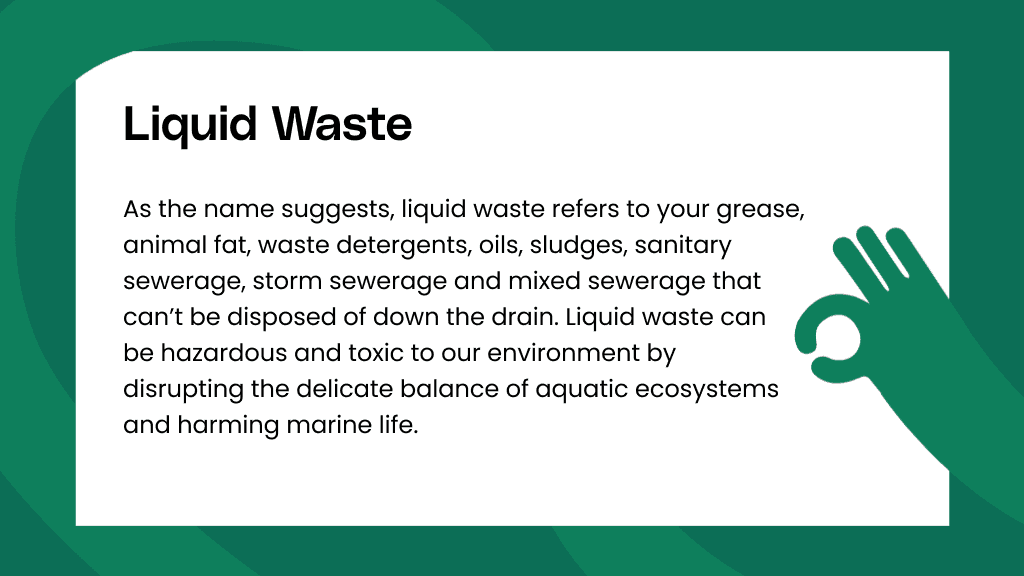Reclaim Waste Can Be Fun For Everyone
Table of ContentsWhat Does Reclaim Waste Do?6 Simple Techniques For Reclaim WasteTop Guidelines Of Reclaim WasteReclaim Waste for BeginnersMore About Reclaim Waste
Check out the kinds, incidents, and kinds of fluid waste. Residential sewage waste describes the waste and products from a household septic system. This kind of waste is created by people in residences, colleges, and other buildings. This only consists of sewage-disposal tanks that have a drain area. The appropriate management and disposal of domestic sewer waste call for fluid waste to be transferred to a sewage treatment plant where the proper approaches and equipment are put on purify and deal with waste.
Commercial waste commonly consists of potential dangers, such as flammable materials or a combination of liquid and solid waste items, and needs an advanced and in-depth disposal procedure. The disposal of industrial waste usually involves the filtering of waste before transportation to guarantee risk-free and appropriate disposal. Industrial waste is developed from byproducts and drainage of commercial procedures and manufacturing.
This sort of waste can not utilize the same sewer monitoring transportation or procedures as septic or industrial fluids. The commercial waste monitoring procedure calls for the inspection and screening of fluid waste before it undergoes the disposal process (liquid waste disposal). Runoff waste is the fluid waste that originates from drainage and excess stormwater in highly populated locations or cities
Drainage waste can trigger contamination and flooding if not taken care of correctly. Making sure correct waste monitoring can stop disasters and lower ecological harm.
How Reclaim Waste can Save You Time, Stress, and Money.
Get in touch with PROS Providers today to discover our waste administration and disposal solutions and the appropriate methods to care for the fluid waste you produce.
(https://www.tumblr.com/reclaimwaste1/766851148823068673/at-reclaim-waste-were-a-national-solutions?source=share)Do you recognize what happens to your water when you end, flush the bathroom or drain the cleaning machine? No? Well, it's worth recognizing. This supposed 'wastewater' is not just an essential source but, after therapy, will be released to our land, waterways or the ocean. Utilized water from commodes, showers, bathrooms, kitchen area sinks, washings and commercial procedures is called wastewater.

water used to cool down machinery or clean plant and devices). Stormwater, a kind of wastewater, is overflow that moves from farming and urban locations such as roofings, parks, gardens, roads, courses and rain gutters into stormwater drains, after rain. Stormwater flows untreated directly to regional creeks or rivers, ultimately getting to the ocean.
Not known Facts About Reclaim Waste
In Queensland, a lot of wastewater is dealt with at sewage treatment plants. Wastewater is delivered from domestic or commercial sites via a system of sewers and pump terminals, called sewerage reticulation, to a sewer therapy plant. City governments build, preserve and operate most sewage treatment plants. Operators are licensed under the Environmental Management Act 1994 to release treated wastewater at an acceptable environmental requirement right into waterways.
The Department of Natural Resources advises city governments concerning managing, operating and maintaining sewerage systems and treatment plants. In unsewered locations, city governments might need owners to mount private or home sewage treatment systems to treat domestic wastewater from toilets, cooking areas, restrooms and washings. The Division of Natural Resources authorizes the usage of household systems when they are proven to be reliable.
In some new class, therapy of some stormwater to eliminate trash, sand and crushed rock has begun using gross toxin catches. Wastewater treatment takes place in 4 stages: Eliminates strong issue.
Makes use of little living organisms knows as micro-organisms to damage down and get rid of continuing to be liquified wastes and great fragments. Micro-organisms and wastes More hints are included in the sludge.
The 45-Second Trick For Reclaim Waste
Nutrient removal is not offered at all sewage treatment plants because it calls for expensive specialised equipment. Clear fluid effluent produced after therapy may still contain disease-causing micro-organisms - liquid waste removal.

The majority of wastewater flows into the sewage system. Under the Act, regional governments carry out authorizations and licences for environmentally relevant activities (Periods) entailing wastewater launches that might have a regional effect.
8 Simple Techniques For Reclaim Waste
Otherwise, examples are taken for lab evaluation. Typically numerous tests are needed to establish the levels of each of the different contaminants such as oils, hefty metals and chemicals in water. Tracking provides valid information about water quality and can verify that permit conditions are being satisfied. The info gotten via tracking offers the basis for making water top quality choices.